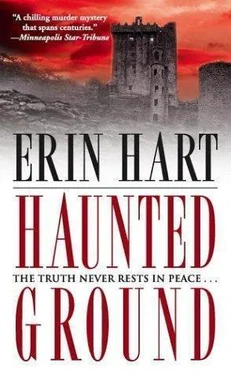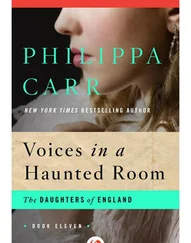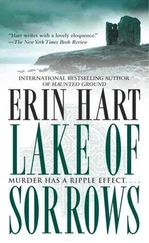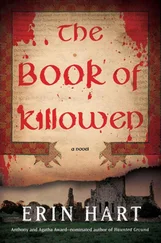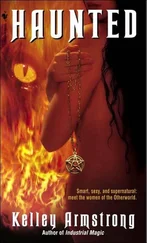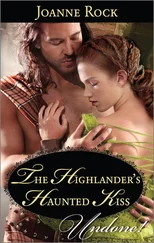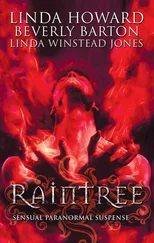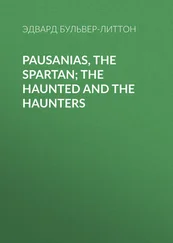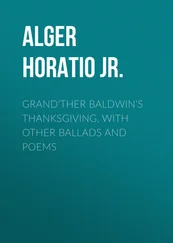“We might be able to hazard a few guesses about how old she is,” Nora said when they’d returned to the examining table. “It’s tough to determine age with any accuracy unless we can get a closer look at her molars. The jaw looks pretty pliable, but we’ll have to be extremely careful.” She used surgical tweezers and a pair of scissors to extract a small piece of skin and a lock of hair for chemical analysis, then a tiny sample of muscle tissue from the girl’s severed neck. She saw Cormac watching closely as she carefully removed a small section of an artery.
“Turns out cholesterol is the most reliable stuff for carbon-dating bog bodies; it’s insoluble in water, less likely to be contaminated by the surrounding material. Without the rest of the body, cause of death is probably going to be an educated guess. There don’t appear to be any ligature marks around the throat. I see several things that point toward decapitation as the cause.”
“Such as?”
“Well, come here for a second. Look at the wound.” Nora reached for the magnifying glass on the tray beside her. “It’s a very clean cut. Look at the way the blood vessels have been sliced through, not torn. Probably a single blow from a fairly sharp blade.” She gestured for him to take the glass, which he did with some trepidation. “You wouldn’t bother being quick about it if the person were unconscious or already dead. And what else could make a person bite down through her own lip like that? She was probably lucky, if that’s how it happened. At least it was over quickly. And look at this.” She pointed to what appeared to be a small abrasion on the girl’s chin. “See how the adipocere, that yellowish waxy material under the skin, is exposed here? Looks to me like a small section of the skin has been cut away. That could have been done with the same blow of the axe—or sword, or whatever kind of blade it was that severed her head.”
He must have looked puzzled. Nora leaned forward impulsively to demonstrate, holding her hands behind her back as if they were bound. She lowered her head to the level of the tabletop.
“Look, if I’m on the block, my natural reaction would be to contract, to become as small as possible.” He studied the back of Nora’s slender neck, the edge of dark hair that stood out against her pale skin, the small hollow between the tendons that supported her head. How easy it must seem, at first, to sever such a vulnerable connection. But how difficult it must prove, as well, considering the toughness of bone and sinew that must be cut through.
“Do you see how it would happen? If my chin is tucked tight, it comes in line with the blade.” She straightened again. “We can probably figure out all kinds of things about how she was killed. But the real question is why? This girl is hardly more than a child. The other thing I can’t get over is how incredibly well-preserved she is. The lab will check of course, but I can’t see any visible evidence of insect eggs or larvae. She must have gone into the bog very soon after her death—which means she was probably killed at or very near the bog.”
“You realize we’ve probably found out all we’re going to about this girl,” Cormac said. He wished there were more as well, but they had to be prepared for reality.
“Yes, I know. But I’m not ready to be perfectly rational about all this yet.”
Should he mention the offer he’d had from Osborne this morning? He could easily drop the whole thing, go on as he had been, finishing his book, preparing to go back to teaching in the fall. He could see his entire future so clearly down that course. Why did he feel that once he stepped from that comfort zone, he would never be able to return? Then again, what was the point of this or any convergence, if not to create new paths?
“Hugh Osborne asked if I’d be interested in coming back to do a small job for him—a general archaeological survey on a construction site.” A light seemed to spring from Nora’s dark blue eyes as she turned to him.
“Oh, Cormac—” she began, then stopped abruptly. “Please tell me you didn’t turn him down.”
“I said I’d have to think about it. It’s too much work for one person—”
“I could help. I’ve got Easter holidays the next two weeks.”
“I couldn’t ask you—”
“But you’re not asking, I’m volunteering. I want to do it. And going back there would give us a chance to find out more about this girl.”
“She could be a hundred or a thousand years old.”
“And in all that length of time, how many red-haired girls do you suppose have been executed in the vicinity of Drumcleggan Bog?” She touched his hand. “Look, I’m not trying to press you into doing something you really don’t want to do. But Cormac, look into her face and tell me you feel nothing, no obligation to find out what happened to her.”
Dropping his gaze to the dead girl’s face, he was again overcome by a familiar, unbidden swell of pity as he answered: “I can’t.”
Even as he spoke, however, Cormac felt the warmth and weight of Nora’s hand on his own, and suddenly realized that the strongest obligation he felt at this moment was not to the red-haired girl on the table, but to the living person who stood across from him, her eyes filled with fierce intelligence and compassion. Hers was the unknown story he felt compelled to explore. Above all, he had the strongest craving to hear her speak his name again.
7
It was nearly nine when Nora left the conservation lab. She navigated the narrow streets just north of Collins Barracks and pulled up near a pub in Stoneybatter called The Piper’s Chair. She had never been in the place, but knew its reputation, and that Cormac Maguire was a regular at its Wednesday night session. The pub itself was a nineteenth-century corner building of no great architectural interest, except that its burnished bar, worn tapestry snugs, and tall windows provided a reminder of dirty old working-class Dublin, and a stark contrast to the trendy, modern bistros that were popping up only a few streets away.
She knew about Cormac’s allegiance to this session through their mutual friend Robbie McSweeney—scholar of history, guitarist, and singer, though she wasn’t sure Robbie himself would put his occupations down in that order. Had he been born five hundred years ago, she thought, Robbie would surely have been in great demand as a harper in the houses of the aristocracy. According to what he’d told her, the same musicians had been coming to the Wednesday night session here for nearly ten years. She gathered there was a strong West Clare connection in this group, most of the players having come from there, or having parents or grandparents who came from that part of the country. The Piper’s Chair was a place tourists were unlikely to find just wandering in off the street, and the regulars liked it that way, because it meant there was little performance pressure and plenty of time for the craic and the chat.
Nora found Robbie sitting at the bar, polishing off a prawn cocktail with his first pint. He raised his eyebrows in greeting as he licked the last of the cocktail sauce off his left thumb.
“Hiya, Nora,” he said, pulling up a seat for her, and signaling the barman. “Will you have a drink?”
“No, thanks, Robbie. I’m just on my way home.”
“So what brings you here to grace our humble presence?”
“I’ve got something to show Cormac.”
“Oh, so it wasn’t music you were looking for, then?”
“Well, that too.” And to try to persuade Cormac to return to Dunbeg, she thought, if he still hadn’t made up his mind. She felt a twinge of guilt that she hadn’t come clean about her own motivations for returning to Galway, which perhaps had as much to do with Hugh Osborne’s missing wife as the red-haired girl.
Читать дальше
